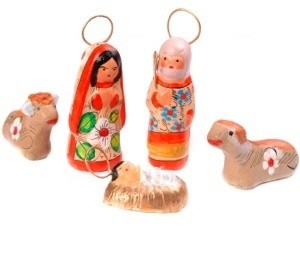
In keeping with my articles this year on International celebrations and foods, I present for your enjoyment a beautiful tradition of the Mexican People. Although this celebration is now mostly celebrated in Mexico, many immigrants are bringing this to America. I first heard about this tradition when I was invited to attend one night of the nine nights of this celebration.
"Las Posadas", the remarkable buildup to Christmas Eve, is perhaps the most delightful and unique Mexican tradition. Las Posadas (Spanish for "the inns") is a nine-day celebration beginning December 16 and ending December 24. It is a yearly tradition with origins in Spain, and symbolizes the trials which Mary and Joseph endured before finding a place to stay where Jesus could be born, based on the passage in the New Testament, the Gospel of Luke (2:1-9):
This tradition dates back to the sixteenth century and St. Ignatius Loyola, who used an Aztec festival to teach about the birth of Christ. He also wanted to replace the nine-day celebration of the birth of the Aztec Sun god with a Christian celebration. What started as a novena, or nine days of prayer, eventually moved from the church to the community and was celebrated in people's homes.
Each family in a neighborhood, will schedule a night for the Posada to be held at their home, starting on the 16th of December and finishing on the 24th on Noche Buena After dark, each night of the "Posada," a procession begins led by two children. Every home has a nativity scene and the hosts of the Posada act as the innkeepers. The neighborhood children and adults are the pilgrims who have to request lodging by going house to house singing a traditional song about the pilgrims. Here is a link to the traditional music sung as they go to house to house, with lyrics and sheet music.
Other members of the company, all with lighted long slender candles, sing the "Litany of the Virgin" as they approach the door of the house assigned to the first "Posada." Four people carry small statues of Joseph leading a donkey, on which Mary is riding. The head of the procession will have a candle inside a paper lamp shade. At each house, the resident responds by refusing lodging (also in song), Those within the house threaten the company with beatings unless they move on.This continues until the weary travelers reach the designated site for the party, where Mary and Joseph are finally recognized and allowed to enter. Together they chant an old traditional song and awaken the master of the house to ask lodging for Mary. Once the "innkeepers" let them in, the group of guests come into the home and kneel around the Nativity scene to pray (typically, the Rosary).
In some places, the final location may be a church instead of a home. Individuals may actually play the various parts of Mary (Maria) and Joseph with the expectant mother riding a real donkey (burro), with attendants such as angels and shepherds acquired along the way, or the pilgrims may carry images of the holy personages instead.
At the end of the long journey, there will be Christmas carols, children will break open pinatas by striking these colorful papier-mache objects with bats while blindfolded to obtain candy hidden inside, and there will be a feast. Traditionally, it is expected to meet all the invitees in a previous procession. At each party of the nine nights, traditional Mexican food is served.
On Christmas Eve at midnight the birth of Christ is announced with fireworks, ringing bells and blowing whistles. Devout worshipers surge into churches to attend the famous "Misa de Gallo" or "Mass of the Rooster." Following Mass, families return home for a tremendous dinner of traditional Mexican foods.
Editor's Note: Here is another article by Debra with more information about this holiday:
Do you celebrate Las Posadas? Share your favorite memories or traditions here.

About The Author: Debra Frick is a mother of 5 and a grandmother to 8 grandsons and one granddaughter. She is a published author and poetress. Recycling and saving money are her passions. She also loves crocheting and cooking. She is also a pet rescue volunteer and has many pets of her own.
Add your voice! Click below to comment. ThriftyFun is powered by your wisdom!